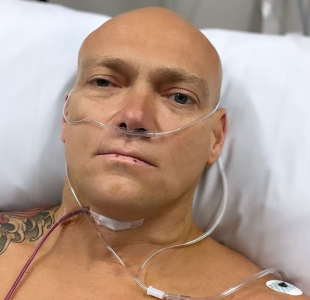‘I neglected the symptoms’: What this Olympian’s journey can teach us all about ageing well
By
Maan
- Replies 0
Health setbacks can be daunting—especially when the warning signs are subtle and easy to dismiss.
One of Australia’s most recognisable sporting figures has opened up about a rare diagnosis that changed the course of his life.
What began as a few minor symptoms quickly spiralled into something far more serious.
What began with cold feet and a bit of numbness became the start of a life-altering journey for one of Australia’s greatest athletes.
Michael Klim, who made his name as a triple Olympian and swimming champion, revealed he was diagnosed with chronic inflammatory demyelinating polyneuropathy (CIDP) in 2020—a rare autoimmune disorder that attacked his nervous system and robbed him of his ability to walk in just six months.
But the 47-year-old admitted the warning signs were there long before things took a turn, and he wished he had acted sooner.
‘I neglected a lot of my symptoms at the onset and I think in a very typical male fashion didn’t act fast enough,’ he shared.
‘So, if anything comes out of our chat, I hope it’s (readers) going to see a doctor even if the symptoms are as simple as getting cold feet when you go to bed or having numbness in your toes or your feet. I neglected some of those.’
At first, Klim said he failed to grasp the seriousness of his condition, pushing through discomfort the way he always had as an elite athlete. But that mindset—instilled through years of training—proved to be a hurdle rather than a help.
‘I had a great team around me but something that was instilled in me as an athlete was that we push through a lot of our discomforts and I continued to do that even in life after sport, which didn’t really lend itself to longevity in life.’
The former swimmer became bedridden and had to come to terms with the reality that he may never walk as he once did. That process took time, and the psychological toll was just as immense as the physical one.
‘Unfortunately, I had my very heart stop when I lost the ability to walk and I think it took me about two years to come to terms with accepting the fact—or almost, it was like there was a grieving period of two years of accepting the fact that my physical ability may never be the same, I may never be able to walk like a normal person, I will be compromised.’
Klim said navigating the unknown has been one of the hardest aspects of living with CIDP, both for him and those closest to him. Unlike typical sports injuries, which come with treatment plans and recovery timelines, his diagnosis offered no such clarity.
‘There was a lot of time of darkness because there is no cure and you’re living in a period of uncertainty—not just yourself as a patient, but your entire support network,’ he said.
‘That was the hardest thing. Previously, my injuries—if I had a rotator cuff injury or sprained ankle—I knew the protocol and knew exactly when I’d be back. But this has been something different and something new and it’s definitely taught me a lot of lessons.’
CIDP occurs when the body’s immune system mistakenly attacks the myelin sheaths that protect the nerves, leading to progressive weakness and loss of sensation—especially in the arms and legs.
Klim, who retired from professional swimming in 2007, remained one of the country's most admired athletes, and his openness about his condition offered a new perspective on resilience and adaptation.
He shared that the condition not only changed how he viewed his own health, but also made him more attuned to the struggles others might be silently carrying.
‘Let’s say 30 per cent of people with CIDP may make a full remission, 30 per cent—where I seem to be fitting at the moment—remain stagnant for the rest of their life, and then 30 per cent of people end up with paralysis, full paralysis or in a wheelchair,’ he said.
‘Even when I wear my braces and I’ve got my pants on, most people look at me and say, “Gee, you’re so fit”. I’ve got my upper body and am still trying to look after myself, but you just don’t know what hardship people are going through underneath.’
Now a father and a figure of strength in a different way, Klim said finding a new sense of purpose was key. No longer driven by medals and race times, he channelled that energy into opportunities and projects that kept him engaged—and hopeful.
‘I was always very driven and active and very quantitative in that I was very opportunistic and attending many things and being involved in many projects.’
Living with a rare condition like CIDP can feel isolating—but understanding what’s happening inside your body can make a world of difference.
If you or someone you love is navigating this diagnosis, this short explainer offers a clear, reassuring breakdown of what CIDP is and how it’s managed.
Watch the video to get the facts—because being informed is one of the best tools we have.
Source: Youtube/GBS-CIDP Canada

Have you ever ignored a health niggle that turned out to be something more serious? Let us know your thoughts in the comments.
In a previous story, we shared Magda Szubanski’s brave revelation about her stage 4 cancer diagnosis and the journey she’s now facing with treatment.
Like Michael Klim, Magda’s story is a powerful reminder that health challenges can come unexpectedly—and that early action and awareness matter, especially as we age.
If you missed her update, it’s well worth the read.
Read more: Magda Szubanski reveals stage 4 cancer diagnosis, begins treatment for rare lymphoma
One of Australia’s most recognisable sporting figures has opened up about a rare diagnosis that changed the course of his life.
What began as a few minor symptoms quickly spiralled into something far more serious.
What began with cold feet and a bit of numbness became the start of a life-altering journey for one of Australia’s greatest athletes.
Michael Klim, who made his name as a triple Olympian and swimming champion, revealed he was diagnosed with chronic inflammatory demyelinating polyneuropathy (CIDP) in 2020—a rare autoimmune disorder that attacked his nervous system and robbed him of his ability to walk in just six months.
But the 47-year-old admitted the warning signs were there long before things took a turn, and he wished he had acted sooner.
‘I neglected a lot of my symptoms at the onset and I think in a very typical male fashion didn’t act fast enough,’ he shared.
‘So, if anything comes out of our chat, I hope it’s (readers) going to see a doctor even if the symptoms are as simple as getting cold feet when you go to bed or having numbness in your toes or your feet. I neglected some of those.’
At first, Klim said he failed to grasp the seriousness of his condition, pushing through discomfort the way he always had as an elite athlete. But that mindset—instilled through years of training—proved to be a hurdle rather than a help.
‘I had a great team around me but something that was instilled in me as an athlete was that we push through a lot of our discomforts and I continued to do that even in life after sport, which didn’t really lend itself to longevity in life.’
The former swimmer became bedridden and had to come to terms with the reality that he may never walk as he once did. That process took time, and the psychological toll was just as immense as the physical one.
‘Unfortunately, I had my very heart stop when I lost the ability to walk and I think it took me about two years to come to terms with accepting the fact—or almost, it was like there was a grieving period of two years of accepting the fact that my physical ability may never be the same, I may never be able to walk like a normal person, I will be compromised.’
Klim said navigating the unknown has been one of the hardest aspects of living with CIDP, both for him and those closest to him. Unlike typical sports injuries, which come with treatment plans and recovery timelines, his diagnosis offered no such clarity.
‘There was a lot of time of darkness because there is no cure and you’re living in a period of uncertainty—not just yourself as a patient, but your entire support network,’ he said.
‘That was the hardest thing. Previously, my injuries—if I had a rotator cuff injury or sprained ankle—I knew the protocol and knew exactly when I’d be back. But this has been something different and something new and it’s definitely taught me a lot of lessons.’
CIDP occurs when the body’s immune system mistakenly attacks the myelin sheaths that protect the nerves, leading to progressive weakness and loss of sensation—especially in the arms and legs.
Klim, who retired from professional swimming in 2007, remained one of the country's most admired athletes, and his openness about his condition offered a new perspective on resilience and adaptation.
He shared that the condition not only changed how he viewed his own health, but also made him more attuned to the struggles others might be silently carrying.
‘Let’s say 30 per cent of people with CIDP may make a full remission, 30 per cent—where I seem to be fitting at the moment—remain stagnant for the rest of their life, and then 30 per cent of people end up with paralysis, full paralysis or in a wheelchair,’ he said.
‘Even when I wear my braces and I’ve got my pants on, most people look at me and say, “Gee, you’re so fit”. I’ve got my upper body and am still trying to look after myself, but you just don’t know what hardship people are going through underneath.’
Now a father and a figure of strength in a different way, Klim said finding a new sense of purpose was key. No longer driven by medals and race times, he channelled that energy into opportunities and projects that kept him engaged—and hopeful.
‘I was always very driven and active and very quantitative in that I was very opportunistic and attending many things and being involved in many projects.’
Living with a rare condition like CIDP can feel isolating—but understanding what’s happening inside your body can make a world of difference.
If you or someone you love is navigating this diagnosis, this short explainer offers a clear, reassuring breakdown of what CIDP is and how it’s managed.
Watch the video to get the facts—because being informed is one of the best tools we have.
Source: Youtube/GBS-CIDP Canada
Key Takeaways
- Michael Klim revealed he was diagnosed with the rare autoimmune disorder CIDP in 2020, which left him unable to walk.
- He admitted to ignoring early symptoms like numbness and cold feet, attributing the delay to a ‘typical male’ mindset.
- The former Olympian said adjusting to life with no clear recovery path took an emotional toll and required a complete mental shift.
- Klim now focuses on staying active, supporting others, and finding purpose beyond his sporting achievements.
Have you ever ignored a health niggle that turned out to be something more serious? Let us know your thoughts in the comments.
In a previous story, we shared Magda Szubanski’s brave revelation about her stage 4 cancer diagnosis and the journey she’s now facing with treatment.
Like Michael Klim, Magda’s story is a powerful reminder that health challenges can come unexpectedly—and that early action and awareness matter, especially as we age.
If you missed her update, it’s well worth the read.
Read more: Magda Szubanski reveals stage 4 cancer diagnosis, begins treatment for rare lymphoma








